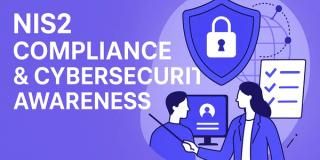Regulatory compliance is no longer just about documentation and firewalls. With threats like phishing, smishing, vishing, and insider error becoming dominant breach vectors, regulators across industries and regions now demand more than technical controls — they expect proactive, organization-wide Cybersecurity Awareness Training (CSAT).
Whether you're operating under GDPR, ISO 27001, SOC 2, or sector-specific laws like HIPAA, DORA, or FERPA, employee behavior is a compliance issue — and human-layer defenses are now a legal requirement.
This guide provides a framework-by-framework breakdown of how CSAT supports compliance, reduces risk, and prepares your organization for audits, inspections, and real-world attacks. Each section links to a dedicated deep-dive article, so you can quickly access tailored guidance.
Why CSAT Is a Compliance Imperative
Across virtually all major cybersecurity and privacy regulations, training is now treated as a core risk mitigation control — not a checkbox. Here’s why:
- 90%+ of breaches involve human error or social engineering
- Regulators require “appropriate” or “reasonable” organizational measures
- Auditors expect measurable, ongoing, role-based education
- Training logs are increasingly requested during investigations
Effective CSAT doesn’t just educate — it simulates, tests, and proves that your people know how to prevent and respond to threats.
How CSAT Maps to Regulatory Objectives
While frameworks vary in language and scope, most share the following expectations:
| Compliance Objective | How CSAT Helps |
|---|---|
| Prevent unauthorized access | Teaches staff to recognize phishing and fraud |
| Protect sensitive/personal data | Reinforces proper handling and redaction |
| Respond to incidents quickly | Trains staff to escalate issues appropriately |
| Reduce breach likelihood | Creates a culture of vigilance and resilience |
| Provide audit-ready evidence | Logs training, simulations, and remediation |
Let’s look at how CSAT applies to specific compliance frameworks.
📚 Compliance Frameworks Supported by CSAT
Each section below links to a full-length guide for that regulation or standard.
🔐 GDPR (General Data Protection Regulation)
CSAT Role: GDPR requires “appropriate organizational measures” to secure personal data (Art. 32), and training is part of a DPO’s duties (Art. 39). Awareness helps prevent unauthorized disclosure of personal data and improves breach response preparedness.
Read the full GDPR & CSAT guide →
📄 ISO/IEC 27001
CSAT Role: Annex A.6.3.2 mandates security awareness for all employees. CSAT helps organizations reduce risk, align with risk assessments, and demonstrate continual improvement across the ISMS lifecycle.
Read the full ISO 27001 & CSAT guide →
✅ SOC 2 Type II
CSAT Role: Trust Service Criteria CC2.2 and CC4.2 emphasize employee training to ensure controls are understood and executed over time. Simulations prove that controls operate effectively across the audit period.
Read the full SOC 2 & CSAT guide →
🏥 HIPAA (Healthcare Privacy & Security Rules)
CSAT Role: HIPAA requires a formal, ongoing security awareness program for all workforce members. CSAT helps prevent PHI exposure from phishing, insider error, or incident mismanagement.
Read the full HIPAA & CSAT guide →
🧩 NIST Cybersecurity Framework (CSF)
CSAT Role: CSAT supports key categories like PR.AT (Awareness), DE.CM (Monitoring), and RS.CO (Response Communication). Training enables maturity across the Identify–Recover lifecycle.
Read the full NIST CSF & CSAT guide →
💳 PCI-DSS (Payment Card Industry Data Security Standard)
CSAT Role: Requirement 12.6 mandates a security awareness program. CSAT reduces fraud, supports audit readiness, and helps protect cardholder data across the organization and third-party environments.
Read the full PCI-DSS & CSAT guide →
🕵️♂️ CCPA / CPRA (California Privacy Laws)
CSAT Role: Training is required for handling consumer data requests and proving “reasonable security” — a legal defense in breach-related claims. CSAT prepares teams to avoid accidental disclosure or mishandling.
Read the full CCPA / CPRA & CSAT guide →
🎓 FERPA (Family Educational Rights and Privacy Act)
CSAT Role: FERPA requires institutions to safeguard education records. CSAT trains educators and admin staff to handle student data appropriately, spot social engineering, and avoid accidental leaks.
Read the full FERPA & CSAT guide →
🛡️ NIS2 (EU Cybersecurity Directive)
CSAT Role: NIS2 mandates cybersecurity training and accountability for essential and important entities. CSAT supports Articles 20–21 by building measurable awareness, including board-level participation.
Read the full NIS2 & CSAT guide →
🏦 DORA (Digital Operational Resilience Act)
CSAT Role: DORA requires training under its ICT risk management framework (Art. 13). Simulations help financial institutions meet governance, incident response, and third-party oversight obligations.
Read the full DORA & CSAT guide →
Our Platform: Built for Compliance Leaders
We provide CSAT designed specifically for organizations navigating complex compliance frameworks:
- ✅ Framework-specific simulation templates
- 📊 Metrics and training logs for audits
- 🔁 Automated refreshers and just-in-time learning
- 🔐 Multilingual, multi-entity deployment
- 🔎 GRC dashboards and evidence reports
Whether you're in healthcare, finance, SaaS, education, or critical infrastructure, our platform helps you embed training into your risk management strategy — not bolt it on.
Conclusion: Train to Comply, Simulate to Secure
Every regulation now recognizes what security teams have known for years: human error is a compliance risk. And while policies and tools are important, they can’t succeed without trained, alert, and accountable people.
By investing in simulation-based Cybersecurity Awareness Training, you’ll not only meet your compliance requirements — you’ll build a resilient security culture that actually works.
Request a Demo
See how our AI-powered CSAT platform helps you meet regulatory obligations across GDPR, ISO 27001, SOC 2, HIPAA, NIS2, DORA, and more.




